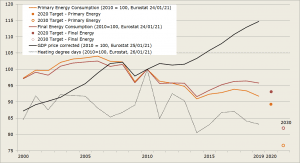2019 saw a declining energy demand, according to latest Eurostat data. This happens the second year in a row now since 2014 when economic growth in the EU picked up again and indeed the EU’s energy efficiency flagship, the energy savings obligation, started.
It means energy demand is absolutely decoupled from economic growth. This is mainly due to energy efficiency improvements. However, 2020 we expect disruptions caused by Corona measures, which leads to a decline in energy efficiency investments according to the International Energy Agency (IEA).
Having a closer look at the 2019 FEC/PEC data shows some interesting trends:
1. 2020 energy efficiency targets are reachable, especially for primary energy consumption (PEC), which declines faster than final energy (FEC). This could be due to the ongoing switch from coal to PV and wind energy. The latter are 100% efficient by convention which compares well to the roughly 30-40% efficiency for coal.
2. Final energy consumption (FEC) looks less good and achieving the 2020 energy efficiency target is uncertain. This is worrying because this is due to our leaky homes and polluting cars. Reducing energy end use is crucial to ensure the transition to a carbon free energy system is socially equitable.
Look out for the for Odyssee-Mure project, which provides more detailed analysis and insights.
